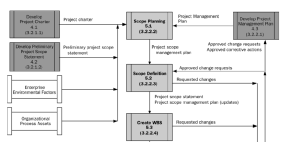One of the “old chestnuts” I heard when I started to consort with project management professionals was the “functional vs. project skills” chestnut. I used to hear from many project pros that all that was really needed for project leadership success was command of the project management body of knowledge (PMBOK). But as the quote from the PMBOK Guide (3rd edition) in the post suggests, the full PMBOK itself is just one element of what must be understood and used.
To that point, a new football blog — American football, for my international readers — is all-in on the value of “functional” knowledge. Football By Football started at the beginning of the 2014 National Football League season, and it lays out its strategy on the home page:
FootballByFootball.com is a football analysis website providing unique player-writer generated content; owned & operated by experienced football players.
Experience counts immensely—especially in analyzing the world’s most complex sport. A tiny percentage of the writing population has football experience. This is a disparity we aim to change.
Football fans crave insight. So, when the world orders a steak, you don’t butcher a chicken.
A great, but subtle, example of the site’s value is a recent post on the “Best Way To Spend Your Bye Week.” The bye week — a week off during the regular season — is a relatively recent innovation in the NFL schedule. I had no real idea of what the players did during the bye — I’m a family guy, so Chris Snee’s account of home time resonated — but the other two vignettes had a couple of “Aha!” moments.
Drew Bennett noted that many players don’t get time off if they are injured and unavailable for practice. The time off was so alluring that walking wounded would rise from their beds, so:
that final practice before the break begins is a riot. You see guys that were on crutches Monday hobbling through pass rush drills. You may see a receiver with a cracked wrist catching passes. You could see someone who barely made it through a meeting with back pain lined up for conditioning.
Matt Chatham highlighted that one’s itinerary during the bye week is a non-obvious choice. Perhaps there’s more structure now, but as I read his piece I realized that the bye week only started in 1990. I doubt that there was a good idea of what to do with that time off, at least not for a while. After all, any downtime was balanced by the fact that the season would resume — in midseason. The players had to jump right back into their midseason mindsets, or risk a loss (or a string of losses). Every game, practice, and event is magnified in the NFL: there are only 16 games and one or two losses can doom a season. Chatham realized that the way his first approaches to his bye week affected his mindset:
I had teammates who went to Jamaica for a few days, which sounded insane to me with a long day of travel on each end. But I got caught up in the idea that ‘I must be missing something,’ so I compromised and went to a beach resort in Florida. I still felt rushed to get down there and back.
No dice. Never again….
I learned. No reason to put myself through that. A little bit of pleasure that somehow made me feel worse in the end.
As they say, read the whole thing.
Filed under: PMO | Tagged: Chris Snee, Domain Expertise, Drew Bennett, Football By Football, Matt Chatham, NFL, PMBOK Guide, time management | 1 Comment »








 There have always been a few in-apt or questionable glossary terms included in the PMBOK Guide‘s glossary. But in particular, the persistence of the
There have always been a few in-apt or questionable glossary terms included in the PMBOK Guide‘s glossary. But in particular, the persistence of the 


